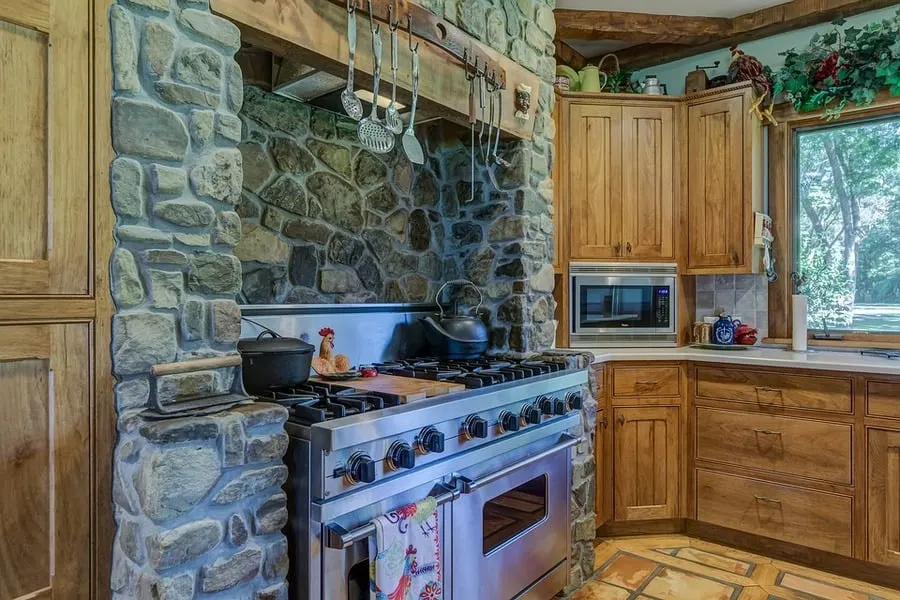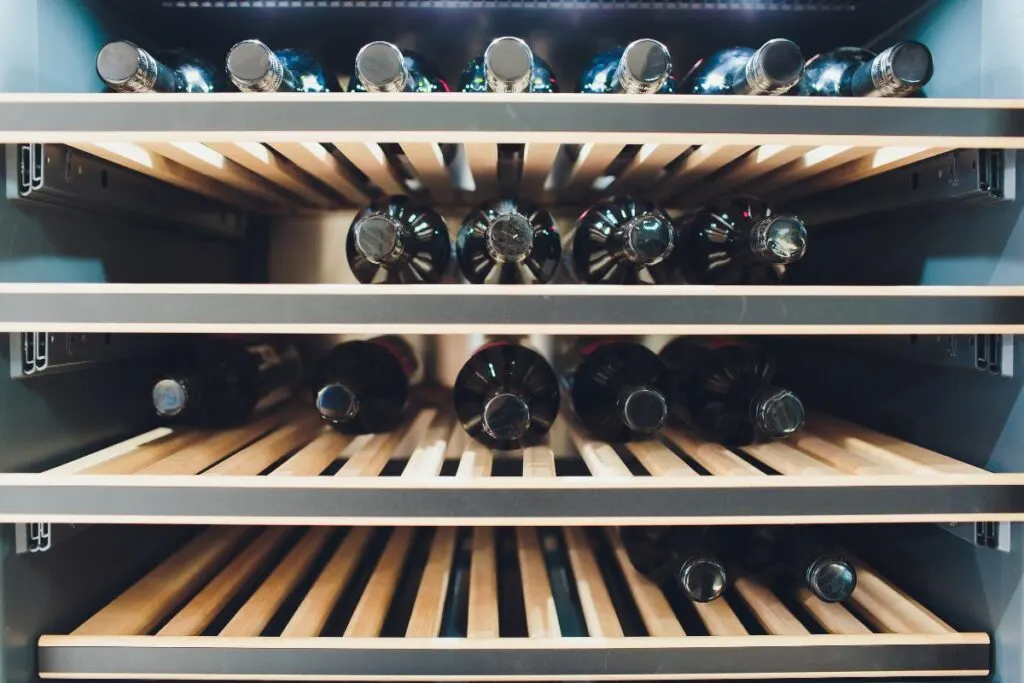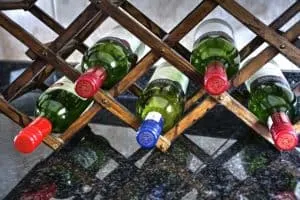As an Amazon Associate, I earn from qualifying purchases with no additional costs for you.
Wine refrigerators can be stored in the kitchen, but is it wise to place them next to an oven? Wine fridges come in a variety of sizes ranging from small countertop models that can hold a few bottles to large units with a storage capacity of over 100 bottles and multiple chilling zones. Given the relatively compact design of wine fridges, the kitchen would seem to be the ideal location for a wine fridge because of its proximity to the dining and entertaining areas of a home.
Can you put a wine fridge next to an oven? It is not advisable to place wine refrigerators next to ovens since wine fridges require proper ventilation and clearance around the unit to avoid overworking the cooling system. Also, their performance is influenced by the ambient temperature around them. Lastly, the refrigerants used in certain models are flammable, so it is necessary to avoid an open flame in case a refrigerant line ruptures.
Ultimately the purpose of a wine fridge is to provide a stable environment with carefully monitored storage temperatures to preserve the fine characteristics of a wine.
In this article, we will take a close look at each of the reasons you should avoid placing a wine fridge next to an oven or other sources of heat. If you want to learn the 11 best places to place a wine refrigerator, you need to read this article I wrote.

TIP: If you want to check out the best refrigerator for wine storage, I recommend trying out the Avation (18 bottles) compressor refrigerator with Wi-fi smart app control cooling system. You can find this refrigerator by clicking here (Amazon link).
Types of Wine Fridges
Before we can begin to discuss the pitfalls of placing a wine fridge next to an oven, it is important to review the two basic categories of wine fridges, which differ primarily in the manner by which they chill wine: (1) compressor-based systems and (2) thermoelectric-based systems. These two different types of wine fridges have their unique issues when it comes to placement.
Compressor Wine Fridges
These models cool the interior cabinet of the wine fridge via a vapor compression cycle, which utilizes the same technology found in kitchen refrigerators.
Compressor wine fridges rely upon a pressurized coolant gas (the refrigerant) that fluxes back in forth between a liquid and vapor state to produce the desired cooling effect inside the unit. Internal fans help circulate the cold air evenly.
Compressor wine fridges can achieve temperatures as low as 38° F and maintain programmed temperatures consistently.
Thermoelectric Wine Fridges
Unlike their compressor counterparts, thermoelectric wine fridges do not use refrigerants and are therefore considered the more environmentally friendly option.
Instead, they utilize a thermoelectric phenomenon known as the Peltier effect by which an electrical current that is fed into a device consisting of two plates of different materials (and electrical conductivity) results in a cooling effect (source).
Thermoelectric wine fridges are not able to cool air as effectively as compressor wine fridges because of their limited heat dissipation and can achieve a low temperature of about 50° F.
The caveat, however, is that these units are particularly susceptible to ambient temperatures as they can only lower the internal fridge temperature to around 20° F below the surrounding temperature.
TIP: Did you know that some wines can be served at room temperature? Read this article to find out which wines don’t need a cooler. What happens if your wine accidentally freezes? Can you still drink it? Find out all the answers here.
Reason #1: Wine Fridges Require Proper Ventilation and Clearance

To work effectively, both compressor and thermoelectric wine fridges require adequate ventilation. Most units have ventilation grills built into their body panels with front-facing and rear-facing vent openings.
Also, manufacturers of both types of wine fridges recommend that free-standing units (as opposed to in-cabinet or under-counter designs) have four to six inches of clearance to either side.
Even though wine fridges are insulated, they are still influenced by surrounding conditions.
Nearly all manufacturers of wine fridges discourage placing units in areas where they will be exposed to direct sunlight for more than an hour because continued exposure will force the fridge’s cooling system to work harder to maintain its internal temperature, which in turn will increase wear on cooling system components.
Although modern ovens are also insulated, if you have ever tried baking for extended periods on a hot summer day, you will know that ovens can raise the air temperature in the kitchen.
Even opening and closing the oven door will cause hot air to escape from the oven, so placing a wine fridge adjacent to the oven will undoubtedly subject it to a direct and indirect heat source.
Reason #2: Wine Fridges are Susceptible to Temperature Fluctuations

Wine fridges are best installed in areas that do not receive direct sunlight and away from HVAC vents and ducts where they will be subjected to temperature variations.
As a general rule, the warmer the environment in which they are placed, the harder they will have to work to chill and store your bottles of wine at the temperature you seek.
While compressor wine fridges are generally capable of adapting to changes in a home’s ambient temperature, although the compressor will engage more frequently as the room temperature goes up.
In contrast, thermoelectric wine fridges’ performance will suffer noticeably if placed in an area that reaches an air temperature of 75° F or above.
And unlike a compressor wine fridge that runs its cooling system as needed to maintain a certain temperature, a thermoelectric wine fridge is constantly running, meaning that it never stops consuming electricity.
Believe it or not, most wine refrigerators aren’t costly to run as long as you avoid the 7 missteps I’ve outlined in this article. They can be very cost-efficient.
If placed in an ambient temperature zone that requires it to work harder for extended periods, you may see a spike in your utility bill.
If you are worried about the repair costs to your wine cooler, check out the below table and factor these prices into your costs before you buy:
| Wine Cooler Part | Costs | Products on Amazon |
|---|---|---|
| Compressor | $100 – $600 | Best Compressors |
| Thermostat | $5 – $30 | Best Thermostats |
| Start relay | $7 – $16 | Best Start Relays |
| Condensor motor | $30 – $250 | Best Condensor Motors |
| Overload protector | $5 – $10 | Best Overload Protectors |
| Cooling fan unit | $10 – $25 | Best Cooling Fan Units |
| Control board | $60 – $250 | Best Control Boards |
| Temperature switching PCB | $30 – $50 | Best PCBs |
| Thermal plate | $30 – $50 | Best Thermal Plates |
As mentioned previously, a thermoelectric wine fridge has limitations on its ability to chill the air inside the unit. Most models can cool and maintain internal temperatures of 20° F to 25° F below the ambient temperature.
According to many wine experts and enthusiasts alike, the safe temperature for storing most wines long-term is 55° F.
For a thermoelectric wine fridge to achieve this temperature, the ambient temperature would need to be a consistent 75° F plus or minus a few degrees.
If the ambient temperature were to rise, even for a short period to 80° F, then the coolest internal temperature a thermoelectric fridge could achieve would be 60° F. This may exceed ideal the storage temperature for certain varietals and vintages.
For this reason alone, it is not advisable to place a wine fridge next to the oven because each time the oven has used the temperature in the surrounding area will rise and force the adjacent wine fridge to work harder to maintain the same internal temperature. This would be particularly true for a thermoelectric unit.
Furthermore, one of the most important aspects of proper wine storage is not only achieving the proper temperature but maintaining it consistently.
Placing a wine fridge, especially a thermoelectric model next to an oven, may jeopardize the long-term quality of your prized wines, particularly those that require a specific cellaring temperature range to be constantly at or below 55° F.
Wine fridges are not necessary to store wine but they can be the best way to ensure your wine is properly stored for long-term storage. In this article I wrote, you’ll learn exactly what conditions need to be met and how a wine cooler may be needed after all.
TIP: Is it really true that you can store wine, or is this just a myth? Find out the true story here! What about decanting wine – true or false? Read this article to find out!
Reason #3: The Dangers of Refrigerant

In 2010, the Environmental Protection Agency (EPA) classified the common refrigerant Freon as a banned substance due to its effect on the ozone layer.
As part of a structured phasing-out process, a complete ban on its production and importation will take effect in 2020. To learn which wine coolers Do and DO NOT use Freon, check out this article I wrote.
This caused many manufacturers of refrigeration and air conditioning products to source alternative refrigerants for their cooling systems. Many compressor wine fridges now use isobutane (R600a) as a refrigerant.
As a substitute for Freon, R600a is very effective as a refrigerant, particularly in smaller appliances such as wine fridges.
Isobutane is naturally occurring and considered non-toxic with zero ozone depletion potential (ODP) and negligible global warming potential (GWP), which are the major environmental hazard markers. On the downside, this refrigerant is highly flammable and explosive.
In the unlikely event that a rupture in the cooling system occurs and this refrigerant was to escape, there would be the danger of an explosion occurring if the leak were to come in contact with an open flame or extreme heat source (e.g., gas or electric stovetop on an oven).
TIP: Wine lovers can help to protect the environment by recycling wine bottles and corks. Find out how here. What happens to plastic wine bottles, and are they environmentally friendly? This article explains all you need to know!
Recommendation box: Everything you need to enjoy your wine as much as possible. All recommended products are personally tested and regularly used by experts from this website (Amazon links):
> Ivation Wine Cooler – Energy-efficient wine cooler for 18 bottles with Wi-fi smart app control cooling system.
> Wine Rack – Beautiful, elegant wood rack for up to 7 bottles and the choice of vertical or horizontal storage.
> Durand Wine Opener – Classic vintage wine opener (we like all these classic staff).
> YouYah Iceberg Wine Decanter – The most beautiful and handy wine decanter we personally use.
> Bormioli Rocco Wine Glasses – A set of eight elegant and traditional wine glasses made in Italy.
> Vintorio Wine Aerator – Simple but really useful wine aerator for a reasonable price.
> The Original Vacu Vin Wine Saver – The best wine saver on the market in a package with two vacuum stoppers and two wine servers.
And if you want to become a true connoisseur of wine, we recommend reading the book Wine Folly: The Essential Guide to Wine (Amazon link), where you will find all the information you need about winemaking, wine varieties, flavors, and much more.
Conclusion: Ovens and Wine Fridges Can’t be Neighbors
Even though wine fridges are insulated (and modern ovens are as well), their performance is nevertheless affected by the conditions that surround them, and putting one next to an oven may cause temperature fluctuations, increase of internal temperature, and accelerated wear and tear of your fridge’s cooling system parts.
Most importantly, your prized wine collection may lose the delicate characteristics and subtle qualities that you seek to preserve by investing in a wine fridge.
Look instead for an area that is protected from sunlight, and that is far enough away from heater vents and other heat sources as to not be subjected to increases in ambient temperature. You’ll thank yourself the next time you pour yourself a glass.
TIP: Check out this page for a complete list of wine products and accessories I love. You’ll find my recommendations for wine refrigerators, decanters, and aerators and the best place to buy wine online. Click here to see the complete listing.
